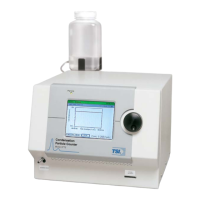5-8 Model 3775 Condensation Particle Counter
High Flow
The high-flow option allows the aerosol sample to be brought to the
CPC faster to minimize response time and reduce particle diffusion
losses. In the high-flow mode, the three-way solenoid valve (see
Figure 5-1) is opened to the bypass flow, closing the makeup air
path. A total of 1.5 L/min is drawn into the CPC, 0.3 L/min flows
through the sensor as the aerosol flow and 1.2 L/min flows as
bypass flow. For information on how to select the high flow mode,
see “
Inlet Flow Mode” section in the “User Settings” section in
Chapter 4.
Low Flow
An inlet flow rate of 0.3 L/min is used when using the CPC in a
Scanning Mobility Particle Sizer spectrometer to measure wider
particle size range. In the low-flow mode, the three-way valve (see
Figure 5-1) is open to the makeup air path, and the bypass flow is
shut off. Only the aerosol flow of 0.3 L/min is drawn into the inlet
and enters the sensor directly. 1.2 L/min makeup air enters the
makeup air port at the back panel of the instrument and mixes
with the aerosol flow before entering the vacuum pump to make up
the 1.5 L/min total flow. For information on how to select the low
flow mode, see “
Inlet Flow Mode” section in the “User Settings”
section in Chapter 4.
Pump
A high-vacuum diaphragm pump is used to maintain a critical
aerosol flow and bypass/makeup air flow. The pump uses a
brushless DC motor with an anticipated life of more than 15,000
hours.
Counting Efficiency and Response Time of
the CPC
The 3775 CPC has a D
50
of 4 nm. D
50
is defined as the particle
diameter at which 50% of particles are detected. The curve fit
shown in
Figure 5-2 is based on testing of three 3775 CPCs using
sucrose particles generated by TSI Model 3480 Electrospray Aerosol
Generator and size classified with TSI Model 3080 Electrostatic
Classifier and Model 3085 Nano Differential Mobility Analyzer
(DMA) . The counting efficiency is calculated by comparing the CPC
readings to TSI Model 3068A Aerosol Electrometer readings.

